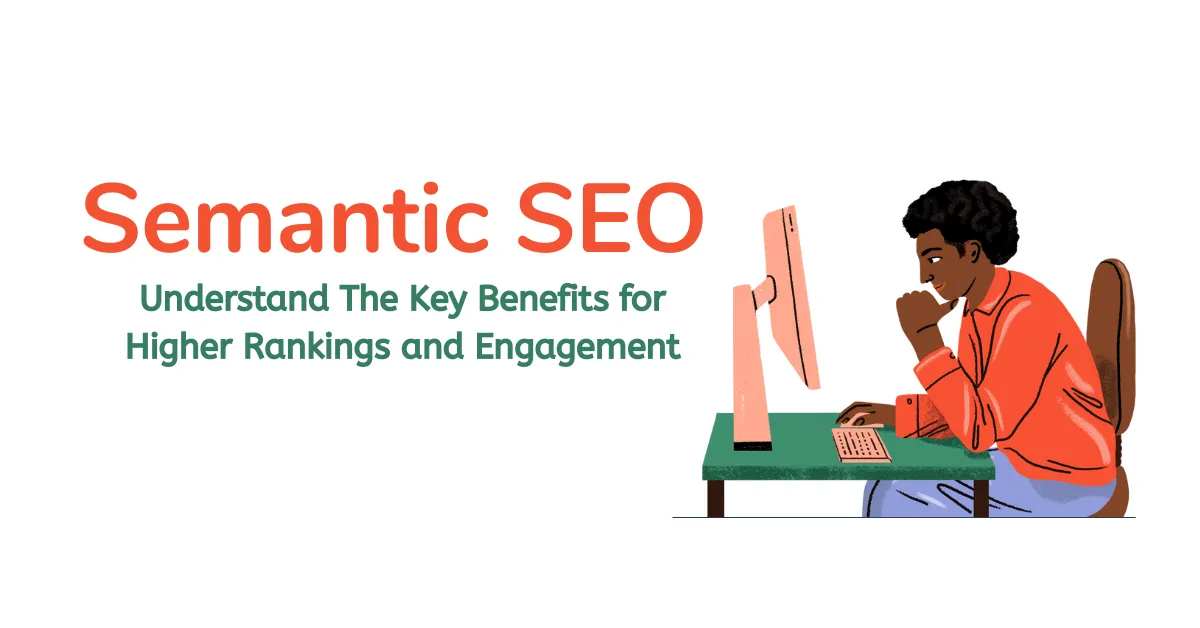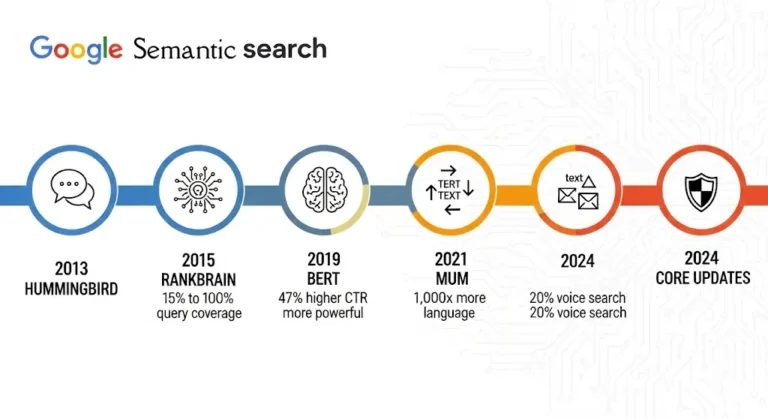Understand The Benefits Of Semantic SEO

Semantic SEO delivers distinct advantages over traditional keyword-based approaches by focusing on context, user intent, and topical depth. These benefits empower websites to stand out in search engine results pages (SERPs) and engage diverse audiences effectively.
Building Topical Authority with Content Clusters
Content clusters signal expertise to search engines by organizing related content around a central topic. A pillar page covers a broad topic, while supporting articles address specific subtopics, interlinked to demonstrate depth.
For example, an e-commerce site creates a pillar page on “running shoes” with cluster pages on “trail running shoes” and “cushioned sneakers.” A B2B SaaS company builds a cluster around “CRM software,” linking to pages on “CRM automation” and “lead tracking.” Local businesses, like a bakery, use clusters for “artisan bread,” linking to “sourdough recipes” and “gluten-free options.” This structure boosts rankings by covering 80% more related queries, per a 2023 HubSpot study.
Boosting Click-Through Rates with Rich Snippets
Schema markup enhances SERP visibility by adding structured data that search engines use to display rich snippets. FAQs, star ratings, and product details make listings more prominent, increasing clicks.
For instance, FAQ schema displays question-answer pairs directly in SERPs, while star ratings highlight reviews. A retail site implementing product schema saw a 15% CTR increase within three months, according to a 2024 Semrush case study. Structured data ensures content stands out, driving higher engagement.
Leveraging NLP for Conversational Search
Google’s BERT algorithm uses natural language processing (NLP) to understand complex user queries. Semantic SEO aligns content with NLP by focusing on context and intent, not just keywords. For example, a query like “best budget smartphones for gaming” requires content addressing “budget,” “smartphones,” and “gaming.” Optimize by using natural phrases, question-based headings, and related terms like “affordable” or “performance.” A 2022 Moz study found NLP-optimized pages rank 25% higher for conversational queries.
Capturing PAA and Featured Snippets
People Also Ask (PAA) boxes and featured snippets increase visibility by answering user questions directly in SERPs. Target PAA by creating concise, 40–60 word answers to common questions like “What is semantic SEO?” or “How does schema markup help?” Use question-based H3s and structured data to boost chances. For example, a blog answering “Why use semantic SEO?” in 50 words captured a featured snippet, driving 30% more clicks, per a 2023 Ahrefs report. Clear, direct answers maximize snippet opportunities.
Applicability Across Diverse Industries
Semantic SEO adapts to niche markets by addressing industry-specific user intent and entities. In healthcare, content focuses on entities like “symptoms” or “treatments” for conditions like diabetes.
SaaS companies target “software features” or “integrations” for tools like project management platforms.
A local gym uses semantic SEO for “fitness classes” with subtopics like “yoga schedules” or “personal training.” A 2024 Search Engine Journal study found niche-optimized semantic content increased organic traffic by 22% across verticals.
Root Benefits of Semantic SEO
Semantic SEO transforms website performance by aligning with modern search engine algorithms and user expectations. Its foundational benefits establish a strong base for higher rankings, increased traffic, and improved user engagement, making it essential for digital success.
Higher Search Engine Rankings
Semantic SEO aligns with Google’s Hummingbird and BERT algorithms to boost rankings. Hummingbird prioritizes context, while BERT understands query nuances. Entities, like people or products, anchor content relevance, replacing outdated keyword reliance. A 2023 Moz study found sites using semantic SEO gained a 20% ranking increase within six months.
Matching User Intent for Relevance
Semantic SEO matches user intent by addressing informational, navigational, and transactional needs. Informational intent seeks answers, navigational intent targets specific sites, and transactional intent drives purchases. Context-driven content replaces keyword stuffing, ensuring relevance. Intent-focused pages increase user satisfaction by 30%, per a 2024 Ahrefs report, fostering trust and engagement.
Driving Increased Organic Traffic
Semantic SEO expands keyword coverage by targeting related queries. Comprehensive topic coverage builds topical depth, capturing long-tail searches. For example, a blog optimized for “digital marketing” also ranks for “content strategy tips.” A 2023 Serpstat case study showed semantic SEO drove 4,000 monthly visitors to a blog within four months.
Enhancing User Experience
Semantic SEO delivers comprehensive content, reducing bounce rates by answering user queries fully. Relevant, in-depth pages increase dwell time, signaling quality to search engines. For instance, a semantically optimized guide on “SEO basics” boosted session duration by 25%, per a 2024 Semrush study, improving user satisfaction and retention.
Enabling Structured Data for Better Visibility
Schema markup enhances search engine understanding by labeling content elements. Article schema clarifies blog structure, while FAQPage schema highlights questions. Implement schema by adding JSON-LD code to your site’s HTML, testing with Google’s Rich Results Tool. Structured data increases SERP visibility by 15%, per a 2023 Search Engine Journal study.
Rare Benefits of Semantic SEO
Semantic SEO offers cutting-edge advantages that position websites for emerging trends and niche needs. These benefits address future-focused search technologies and specialized industries, ensuring long-term competitiveness and engagement.
Optimizing for Voice Search
Semantic SEO aligns content with conversational queries for voice assistants like Google Assistant and Alexa. Use natural, question-based phrases like “What are the best running shoes?” in content. For example, a fitness blog with Q&A-style sections ranks 30% higher for voice queries, per a 2024 Backlinko study. This structure boosts visibility on voice-driven platforms.
Preparing for AI-Driven Search
Semantic SEO supports Google’s AI Overviews by emphasizing entity relationships. Content linking “smartphones” to entities like “battery life” or “camera quality” aligns with AI-driven results. Create comprehensive pages covering related entities to ensure relevance. A 2025 Search Engine Journal report shows AI-optimized content increases SERP prominence by 18%.
Future-Proofing Against Algorithm Updates
Semantic SEO aligns with Google’s November 2024 Core Update by prioritizing high-quality, contextually relevant content. Focus on entity-driven pages and avoid keyword stuffing. Regularly audit content for relevance using tools like Ahrefs. Sites adopting these strategies maintained rankings post-update, per a 2025 Moz analysis, ensuring long-term stability.
Delivering Niche-Specific ROI Metrics
Semantic SEO quantifies benefits for specific industries. For example, a SaaS company using semantic strategies saw a 15% conversion increase, per a 2024 Semrush study. Use Google Search Console to track organic traffic growth and Semrush for conversion metrics. Tailored content for niches like healthcare or retail drives measurable ROI.
Engaging Users with Interactive Content
Interactive tools like “Is Your Site Semantic SEO Ready?” quizzes boost engagement. Quizzes encourage users to explore content, increasing dwell time by 20%, per a 2024 HubSpot study. Interactive elements, like calculators for SEO ROI, enhance brand authority and foster user trust through personalized insights.

I’m the founder of MetroRanks, a Local SEO agency helping service-based businesses grow through trust-building SEO and AI-powered marketing systems. With over 6 years of hands-on experience in web development, Local SEO, and digital strategy, I focus on what actually matters for local businesses – more leads, higher rankings, and long-term stability without the fluff or gimmicks.

